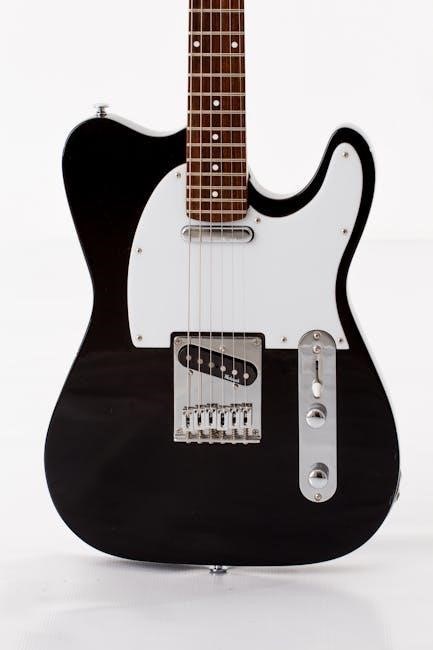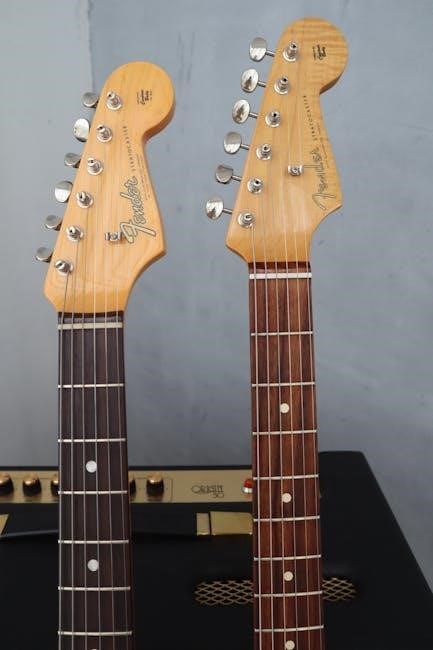The Telecaster String Guide is an essential resource for optimizing your guitar’s sound and playability. Explore the essential aspects of string selection, setup, and maintenance to unlock your Telecaster’s full potential.
Understanding the Importance of Strings on a Telecaster
Your Telecaster’s strings are crucial for achieving optimal sound quality and playability. They directly impact the guitar’s tone, sustain, and responsiveness, making the right choice essential for your musical style. Properly set up strings ensure smooth action, reduce tuning issues, and prevent string buzz or rattling. Different gauges and materials can dramatically alter your Telecaster’s voice, from bright twang to rich sustain. Additionally, strings influence the guitar’s tuning stability and overall performance, especially during bending and vibrato. Regular maintenance and correct setup are vital to preserving your strings’ integrity and ensuring your Telecaster plays and sounds its best.
A Brief History of the Telecaster and Its String Setup
The Telecaster, introduced in the early 1950s, revolutionized electric guitars with its simple, durable design. Originally lacking a string guide, it later incorporated one to improve tuning stability, especially for the higher-pitched B and E strings. This design evolution reflects the guitar’s adaptability to player needs. The Telecaster’s string setup has remained largely consistent, emphasizing clarity and twang, while its versatility has made it a favorite across genres. Understanding its history helps players appreciate how its string configuration contributes to its iconic sound and playability.

Choosing the Right Strings for Your Telecaster
Selecting the perfect strings for your Telecaster involves considering gauges, materials, and brands to enhance sound and playability, ensuring your guitar delivers its signature twang and versatility.
String Gauges: Light, Medium, and Heavy Options
String gauges play a crucial role in shaping your Telecaster’s tone and playability. Light gauges (e.g., .009–.042) offer ease of bending and a bright, snappy sound, ideal for country and jazz. Medium gauges (e.g., .010–.046) provide a balanced tone with excellent clarity, making them versatile for most genres. Heavy gauges (e.g., .011–.052) deliver robust sustain and a fuller sound, perfect for rock and blues. Choosing the right gauge depends on your playing style and musical preferences. Experimenting with different gauges can help you find the perfect feel and tone for your Telecaster.
String Materials: Nickel, Steel, and Coated Options
String materials significantly influence your Telecaster’s tone and playability. Nickel-wound strings offer a warm, vintage sound with a smooth feel, ideal for classic country and jazz. Steel strings provide a bright, crisp tone with enhanced durability, making them great for rock and blues. Coated strings, such as Elixir or D’Addario XL, feature a protective layer that reduces corrosion and extends string life. Each material caters to different playing styles and musical genres. Experimenting with these options allows you to tailor your Telecaster’s sound to suit your artistic expression and performance needs.
Recommended String Brands for Telecaster
When selecting strings for your Telecaster, trusted brands like Fender, Elixir, D’Addario, and Ernie Ball are excellent choices. Fender strings are known for their consistency and vintage tone, while Elixir’s coated strings offer durability and reduced finger squeak. D’Addario XL strings provide a balanced sound with excellent playability. Ernie Ball Slinkys are favored for their bright, responsive feel. These brands cater to various playing styles and tonal preferences. Whether you’re seeking classic twang or modern versatility, these options ensure high quality and reliability, helping you achieve the sound you desire for your Telecaster.

The Telecaster String Guide: A Comprehensive Overview
This guide provides an in-depth look at optimizing your Telecaster’s performance through proper string selection, setup, and maintenance, ensuring enhanced playability and tone for all players.
What is a String Guide and Its Purpose
A string guide, often called a string tree, is a small component mounted near the guitar’s headstock. Its primary purpose is to direct the strings toward the tuning posts, ensuring proper alignment and tension. This helps maintain consistent tuning stability, especially for the thinner E and B strings, which are prone to slipping. The string guide reduces sympathetic overtones and prevents strings from buzzing or rattling against the headstock. Available in traditional and roller-style designs, it enhances playability while protecting the strings from wear caused by sharp edges. Proper installation and adjustment are crucial for optimal performance and tone.
Types of String Guides: Traditional vs. Roller-Style
There are two primary types of string guides for Telecasters: traditional and roller-style. The traditional string guide features a fixed, non-moving design, often with a simple, wavy or flat shape. It is cost-effective and easy to install but can sometimes cause string wear if set too low. The roller-style string guide incorporates small rollers that allow the strings to move smoothly, reducing friction and enhancing tuning stability. This design is particularly beneficial for players who frequently bend strings or use tremolo systems. Choosing between the two depends on your playing style, with traditional offering simplicity and roller-style providing improved performance and string longevity.
How to Install a String Guide on Your Telecaster
Installing a string guide on your Telecaster is a straightforward process that enhances tuning stability and string alignment. Start by removing the old string guide if present, taking care not to damage the headstock. Position the new guide near the D and G string tuning posts, ensuring proper alignment with the strings. Mark the screw holes lightly with a pencil, then drill pilot holes to avoid splitting the wood. Secure the guide with screws, tightening evenly. Adjust the guide to apply gentle pressure on the strings, ensuring they sit correctly in the nut. Test tuning stability by playing open strings and bends to confirm proper setup.
Troubleshooting Common Issues with the String Guide
Common issues with the string guide include tuning instability, string buzzing, and improper alignment. If the high E and B strings frequently go out of tune, check if the guide is applying too much pressure. A guide set too low can cause sharp bends, leading to tuning problems. Additionally, buzzing may occur if the strings are not properly seated in the nut. To resolve these issues, adjust the guide to apply gentle pressure and ensure the strings are aligned correctly. Consider upgrading to a roller-style guide to reduce friction and enhance tuning stability. Regularly inspect the guide for wear and tear.

String Setup and Maintenance
Proper string setup and regular maintenance are crucial for optimal playability and tone. Clean strings, adjust the nut and bridge, and ensure proper action to maintain performance and longevity.
The Importance of Proper String Setup for Playability
Proper string setup is essential for achieving optimal playability on your Telecaster. Correct string action (the height of the strings above the fretboard) ensures ease of playing without causing buzzing or rattling. Proper intonation adjustment guarantees accurate tuning across all frets, while a well-adjusted nut ensures smooth playing in the lower frets. Improper setup can lead to discomfort, tuning issues, and a less enjoyable playing experience. Regular maintenance, such as cleaning and stretching strings, also contributes to consistent performance. A properly set up guitar not only sounds better but also enhances overall playability, making it more enjoyable for musicians of all skill levels.
Step-by-Step Guide to Changing Strings on Your Telecaster
Changing strings on your Telecaster is a straightforward process when done correctly. Begin by loosening the old strings with a tuner until they are no longer taut. Remove each string carefully to avoid scratching the guitar. Clean the bridge and nut with a soft cloth to ensure optimal performance. Install the new strings, starting with the low E and moving to the high E, winding them neatly around the tuning pegs. Tighten each string to its proper pitch using a tuner. Stretch the strings by pulling them gently away from the fretboard to eliminate tuning instability. Finally, cut the excess string ends for a clean look and smooth playability.
Adjusting the Nut and Bridge for Optimal String Performance
Properly adjusting the nut and bridge is crucial for achieving optimal string performance on your Telecaster. Start by ensuring the nut is evenly cut to allow strings to sit correctly without buzzing. Use a nut file to make adjustments, checking each string at the first fret to ensure they don’t rattle. For the bridge, lower or raise the saddles to achieve the desired string action, ensuring even playability across the fretboard. Tighten the bridge screws firmly to maintain stability. Finally, tune your guitar and test each string to ensure proper pitch and clarity. Regular adjustments will enhance both sound quality and playability.
Regular Maintenance Tips for Your Strings
Keep your Telecaster strings in prime condition with regular maintenance. Clean strings with a soft cloth after playing to remove sweat and oils, preventing corrosion. Use a mild fretboard cleaner for stubborn grime. Avoid harsh chemicals that can damage finishes or harm skin. Store your guitar in a dry, cool environment to prevent string rust. Change strings every 3-6 months, depending on usage, to maintain tone clarity. When installing new strings, stretch them gently to stabilize tuning. Inspect strings regularly for signs of wear, such as fraying or dullness, and replace them as needed to ensure optimal performance and sound quality.

Additional Components That Affect String Performance
Beyond strings, components like the nut, bridge, and tuning machines significantly influence playability and tone. Proper setup ensures optimal tuning stability and prevents issues like buzzing or tuning inconsistencies.
The Role of the String Tree in Your Telecaster
The string tree plays a vital role in maintaining proper string alignment and tension on your Telecaster; It reduces sympathetic overtones and enhances tuning stability, especially for the high E and B strings. Typically placed near the tuning posts, it ensures strings stay in their correct path, preventing buzzing or rattling. Traditional disc-style trees are common, while roller-style designs minimize friction for smoother tuning. Upgrading to a high-quality string tree can improve playability and tone. Proper installation is key to avoid damaging strings or affecting performance. A well-functioning string tree is essential for achieving optimal sound and tuning stability on your Telecaster.
Upgrading Your String Tree for Better Tuning Stability
Upgrading your Telecaster’s string tree can significantly enhance tuning stability and overall performance. Traditional disc-style trees can sometimes cause friction, leading to tuning issues, especially with the high E and B strings. Switching to a roller-style string tree reduces friction and allows smoother tuning. Fender’s Pure Vintage or Wilkinson-style trees are popular upgrades, offering better functionality while maintaining a classic look. Proper installation ensures optimal string alignment and tension, minimizing the risk of tuning problems. A high-quality string tree is a simple yet effective modification to improve your Telecaster’s playability and sound consistency.
Understanding the Importance of the Nut and Its Impact on Strings
The nut plays a critical role in your Telecaster’s setup, directly influencing string performance and tone. It ensures proper string alignment, spacing, and height, which are essential for tuning stability and playability. A well-cut nut allows strings to vibrate freely, producing clear, resonant tones. If the nut is too high or low, it can cause tuning issues, string buzz, or high action. Regular maintenance, such as cleaning and checking the nut, is vital to prevent dirt buildup, which can affect string performance. Upgrading to a high-quality nut, like a bone or graphite nut, can enhance sustain and clarity, making it a worthwhile investment for optimal sound quality.

Customizing Your Telecaster’s Sound with Strings
Customizing your Telecaster’s sound with strings allows you to tailor its tone to your style. Experiment with gauges, materials, and windings to achieve desired brightness, sustain, or smoothness.
How Different String Gauges Affect Tone and Playability
Different string gauges significantly influence both tone and playability on a Telecaster. Lighter gauges (0.009–0.042) offer easier bending and a brighter, snappier sound, ideal for jazz and clean tones. Medium gauges (0.010–0.046) provide a balanced tone with good sustain, making them versatile for most genres. Heavy gauges (0.011–0.052) deliver deeper lows, increased sustain, and a fuller sound, often preferred by rock and blues players. Heavier strings, however, can feel stiffer and may require more finger strength. Choosing the right gauge depends on your playing style and the musical genre, ensuring optimal tone and comfort for your Telecaster.
Exploring Alternative Materials for a Unique Sound
Exploring alternative string materials can unlock a unique sound for your Telecaster. Nickel-wound strings offer a warm, vintage tone with smooth playability, while steel strings provide brightness and clarity. Coated strings, like Elixir or Ernie Ball Slinky Cobalt, extend life and reduce finger noise. For a distinct flavor, consider flatwound or bronze strings, which deliver smooth, mellow tones. Experimenting with these materials allows you to tailor your sound to genre-specific needs, whether it’s jazz, rock, or country. Each material brings its own sonic character, enabling you to customize your Telecaster’s voice for a truly personalized playing experience.
Experiments with String Windings and Coatings
Experimenting with string windings and coatings can significantly enhance your Telecaster’s tone and playability. Round-wound strings provide a bright, aggressive sound, while flat-wound strings deliver a smooth, mellow tone. Coated strings, such as Elixir or Ernie Ball Slinky Cobalt, reduce finger noise and corrosion, offering a longer lifespan. Additionally, stainless steel or titanium windings can add clarity and sustain to your sound. Exploring these variations allows you to tailor your strings to your playing style and musical genre, whether you prefer crisp articulation or warm, vintage tones. This customization ensures your Telecaster’s sound is uniquely matched to your artistic vision.

Troubleshooting Common String-Related Issues
Address issues like tuning instability, string buzz, and uneven playability by adjusting setups, ensuring proper nut alignment, and maintaining clean, well-stretched strings for optimal performance.
Why Your Strings Might Be Going Out of Tune Frequently
Frequent tuning issues on your Telecaster can stem from improper string tree setup, causing uneven tension. Sharp edges on the string guide can cut into strings, leading to slippage. Additionally, a poorly fitted nut or bridge can disrupt string alignment and stability. Using low-quality or old strings increases the likelihood of tuning problems. Environmental factors like humidity changes or extreme temperatures can also affect string stability. Regularly checking and adjusting your setup, ensuring smooth surfaces, and using high-quality strings can help mitigate these issues and improve overall tuning consistency.
How to Fix String Buzz and Rattling on Your Telecaster
String buzz and rattling on your Telecaster are often caused by low string action, uneven frets, or improper nut and bridge setup. To fix this, start by checking the neck relief and adjusting it if necessary. Raise the bridge saddles slightly to increase string action, ensuring even playability across the fretboard. Use a screwdriver to carefully raise the saddles and test each string. If buzzing persists, inspect the nut for low slots and file them with a nut file. Additionally, check for uneven frets using a fret rocker and level them if needed. Proper setup will eliminate unwanted noise and improve playability.
Solving Issues with String Alignment and Playability
String alignment and playability issues on your Telecaster can often be resolved by adjusting the nut and bridge. Ensure the nut slots are properly cut to guide the strings evenly, and check for any misalignment that could cause uneven playability. If strings are buzzing or sitting too low, raise the bridge saddles slightly to increase action. For high strings, lower the saddles to achieve a balanced feel. Additionally, inspect the string tree to ensure it’s properly seated and guiding the strings correctly. Proper adjustment of these components will enhance playability and ensure smooth performance across the fretboard.

Advanced Tips for Optimizing Your Telecaster’s Strings
For optimal performance, adjust the string action at the bridge and nut, ensuring proper intonation. Experiment with tremolo systems for pitch variations and maintain string health through regular cleaning.
Using String Trees to Enhance Tuning Stability
String trees are crucial for maintaining proper string alignment and tension, especially on Telecasters with straight headstocks. They create a consistent back-angle at the nut, reducing tuning instability and string slippage. Traditional and roller-style trees are available, with roller-styles offering smoother operation and less friction. Proper installation ensures even pressure across all strings, preventing buzzing and improving sustain. Adjusting or upgrading your string tree can significantly enhance tuning stability, particularly for players who bend strings frequently or use tremolo systems. Regular maintenance and alignment checks are essential to maximize their effectiveness and keep your Telecaster sounding its best.
Adjusting the Bridge for Proper String Action
Adjusting the bridge is vital for achieving optimal string action on your Telecaster. Properly set, the bridge ensures comfortable playability and consistent tone. Begin by measuring the string height at the 12th fret, aiming for Fender’s recommended specifications. Adjust the saddles height by turning the adjustment screws, ensuring evenness across all strings. The bridge’s overall angle should align with the neck’s relief for proper alignment. After adjustments, check string action at multiple frets and play styles to ensure stability. Correct bridge setup enhances both tone and playability, making it a cornerstone of your Telecaster’s maintenance routine.
Customizing Your String Setup for Specific Genres
Customizing your Telecaster’s string setup allows you to tailor its sound to specific genres. For classic country, lighter gauges emphasize clarity and twang, while medium gauges suit rock and blues, delivering sustain and crunch. Jazz players often prefer smoother materials like nickel or coated strings with medium-light gauges for warmth and articulation. Experimenting with string gauges and materials can help you achieve the desired tone for your musical style. Whether it’s the bright snap of country or the smooth tones of jazz, the right string setup ensures your Telecaster performs optimally for your genre.

Exploring Different Playing Styles with Your Strings
Explore how string choices impact playing styles. Lighter gauges enhance bending and vibrato for rock, while heavier gauges provide sustain for blues. Experiment to find your perfect match.
Classic Country Twang: String Choices and Setup
For the iconic country twang, choose strings that emphasize brightness and clarity. Lighter gauges (0.009–0;042) provide the snap and definition needed for crisp, articulate tones. Nickel-wound strings are preferred for their warm, yet crisp sound, which cuts through mixes. Proper setup is key: ensure the nut and bridge are adjusted for optimal string action and intonation. A lower action allows for effortless bends, while a precise nut slot prevents tuning issues. Experiment with slightly heavier gauges for added sustain in country styles like chicken pickin’. The right string setup will make your Telecaster sing with that unmistakable twang beloved by country legends.
Rock and Blues: Heavier Gauges for Sustain and Crunch
For rock and blues, heavier string gauges (0.010–0.052) deliver the sustain and crunch needed for powerful riffs and solos. Stainless steel or nickel-wound strings offer robust tone and durability. Heavier gauges provide better stability for bending and sliding, while their increased tension enhances sustain. Pair these with a slightly higher action for reduced fret buzz and clearer articulation. Adjust the bridge for proper intonation to ensure every note rings true. This setup is ideal for players seeking a bold, resonant sound with the bite and character that defines rock and blues music on the Telecaster.
Jazz and Clean Tones: Smoother Materials and Gauges
For jazz and clean tones, lighter string gauges (0.009–0.042) and smoother materials like nickel or flatwound strings are ideal. These setups provide a mellow, articulate sound with reduced finger noise. Lighter gauges make intricate fretwork easier, while smoother materials minimize brightness, offering a warm, balanced tone. This configuration is perfect for players seeking clarity and precision without harsh overtones. Pair these strings with a well-adjusted nut and bridge for optimal playability and sustain. A clean amp setting with minimal effects enhances the natural tone, making it perfect for jazz and other genres requiring refined, polished sound.

Upgrading and Customizing Your Telecaster’s Hardware
Upgrading your Telecaster’s hardware can enhance its performance and tone. Consider replacing the bridge, tuners, or string tree for improved sustain and tuning stability. Customizing these components allows you to tailor your guitar to your playing style and musical preferences, ensuring optimal functionality and sound quality.
Changing the String Gauge for a Different Feel
Changing the string gauge on your Telecaster can dramatically alter its feel and tone. Lighter gauges (0.009–0.042) offer easier playability and a brighter, snappier sound, ideal for fast playing and clean tones. Medium gauges (0.010–0.046) provide a balanced feel and are versatile for most genres. Heavier gauges (0.011–0.052) deliver greater sustain and a fuller tone, perfect for rock, blues, and players who prefer a firmer string tension. Experimenting with different gauges allows you to tailor your guitar to your playing style and musical preferences, ensuring the best possible performance and sound quality.
Experimenting with Alternative String Materials
Exploring alternative string materials can significantly enhance your Telecaster’s tone and playability. Nickel-plated strings offer a warm, vintage sound, while stainless steel strings provide brightness and durability. Coated strings, such as Elixir’s Optiweb or Ernie Ball’s Slinkys, reduce finger noise and corrosion, offering a smooth playing experience. For a unique sound, try flatwound strings for a mellow, jazz-like tone or bronze-wound strings for added warmth. Each material brings distinct characteristics, allowing you to customize your guitar’s voice to suit your musical style. Experimenting with these options ensures you find the perfect balance of tone, feel, and durability for your Telecaster.
Custom String Sets for Unique Tonal Preferences
Custom string sets allow you to tailor your Telecaster’s tone to your specific musical style. By mixing different gauges and materials, you can create a balanced sound that enhances playability and sustain. For example, combining lighter gauges on the lower strings with heavier gauges on the higher strings can provide clarity and smoothness. Experimenting with materials like nickel, stainless steel, and coated strings can also yield unique tonal profiles. Whether you prefer a vintage warmth or modern brightness, custom string sets offer flexibility to achieve your desired sound.
Exploring these configurations can help you discover new sonic possibilities, making your Telecaster truly one-of-a-kind.
